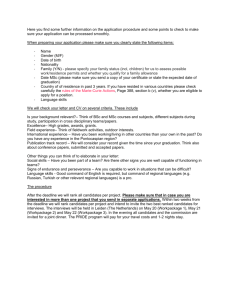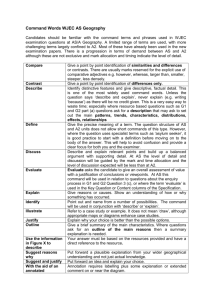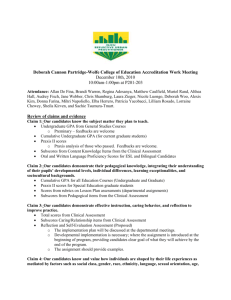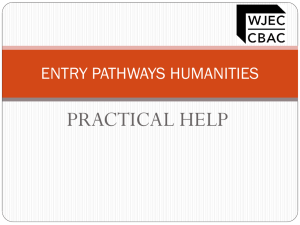Unit 1 Foundation successes
advertisement
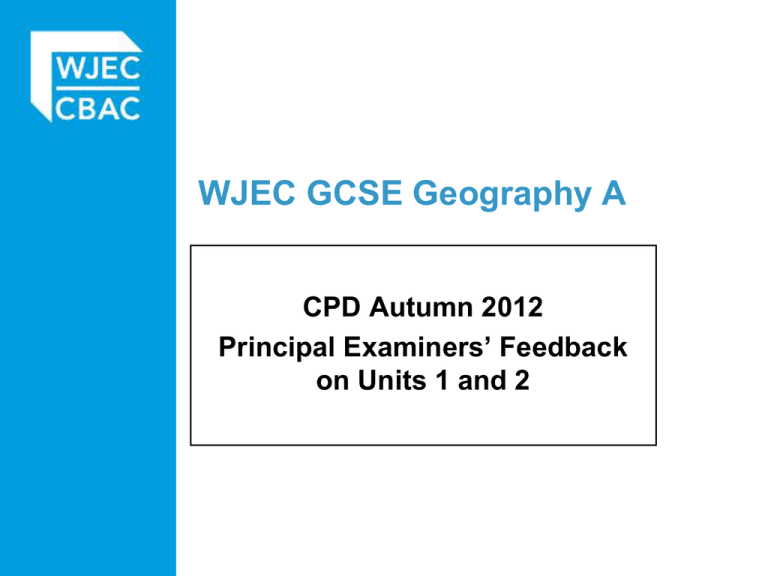
WJEC GCSE Geography A CPD Autumn 2012 Principal Examiners’ Feedback on Units 1 and 2 Assessing AO3 Ideally 32/90 marks for AO3 in Unit 1. What is the implication for designing schemes of work? 16 14 12 10 AO1 AO2 AO3 8 6 4 2 0 Unit 1 Unit 2 Unit 3 Interpretation of maps… • Use points of the compass and the scale line to describe – Distance – Direction OS map skills… • Integrate OS and other maps into your thematic teaching • Use map evidence means to take specific detail – named features – grid refs Saltmarsh floods at high tide in grid square 3582 Low spot height at 302819 Embankments in grid square 3082 … and graphs • Describe trend – Increase / decrease – Slow / rapid – Smooth / erratic / fluctuating • Quantify to get final mark Unit 1 Foundation successes • Q1 Case study knowledge of Boscastle was used well by some. • Q2 Keeling Curve: most candidates described trend and quantified it. • Q3 many candidates were able to describe the effects of an earthquake on people – although named examples were lacking in (c). • Q4 good graph skills and good understanding of factors affecting birth / death rates Unit 1 Foundation Action points • Many candidates need to develop extended writing that includes specific examples / detail. 3 (c) Explain why people continue to live close to active volcanoes despite the dangers they pose. [5] 4 (c) Explain why many people in MEDCs now prefer to live in rural areas. [5] 6 (c) Describe ways in which aid agencies are helping LEDCs to meet one Millennium Development Goal you have studied. [5] Unit 1 Foundation Action points continued • In theme 1, understanding of the drainage basin and factors that affect flooding is weak. • Processes / landforms on constructive plate boundaries are less well understood than destructive boundaries • Scattergraphs (eg Q6) need practice Unit 1 Higher successes • Some improvement in extended writing with more candidates providing detailed/specific knowledge for 6 mark questions. • Climate change is a secure area of knowledge / understanding for most. • Some excellent responses to 3 (b): Explain how the impact of earthquakes on people’s lives may be reduced. [6] Unit 1 Higher Action points • • • • Read question carefully Q1 (a) (iii) Use examples to achieve level 3 Note marks available Q2 (a). Develop the skill of drawing and labelling a diagram Q3 (a) (iii). • Make full use of resources Q4 (b) Unit 2 Foundation successes • Theme 7 (coasts) identification of landforms is very good. Processes and landform development are explained v well by some – others need to explain process. • Description of patterns on graphs is improving eg Q3 temperature pattern on climate graph of tundra described well. • Theme 11 (retail and urban change) was answered well with good graph skills and candidates showing understanding of both benefits and problems associated with internet retailing. Unit 2 Foundation Action Points • Candidates need to practice past questions that test AO2 and AO3 eg use of compass points to describe location 4 (a) (i) Describe the location of the island of Lefkada. [2] • Many candidates write very generic answers to 6 mark questions. They need to develop extended writing that includes specific and located examples eg Q2 overall quality was disappointing. 2 (b) (iii) Using one or more examples explain ways in which the effects of tropical storms can be reduced. [6] Unit 2 Higher successes • Theme 8 K&U of summer and winter anticyclones is good and well supported by examples – perhaps better understood than cyclones? • Quality of case studies is variable: The best candidates include specific detail. Those used in the tourism are generally better / more relevant. Unit 2 Higher Action points • Quality of both diagrams and labels / annotation remains poor. • Some candidates confuse labelling with annotation. Unit 2 Higher Action points continued • Read the question eg Q1 (c) and 3 (c). 1 (c) Rising sea levels pose a threat to many coastal areas. [8] Explain how different coastal management strategies along the coastline can be used to reduce this threat. 3 (c) To what extent have people been successful in managing their use of natural ecosystems? [8] Unit 2 Higher Action points continued • Map reading skills: candidates need to be precise: 3 (a) (i) Describe the global distribution of the tropical rainforest biome. [2] • Case studies are often named but not developed. Add specific detail to show thorough knowledge and understanding eg Q3 and Q5. 3 (c) To what extent have people been successful in managing their use of natural ecosystems? [8]




